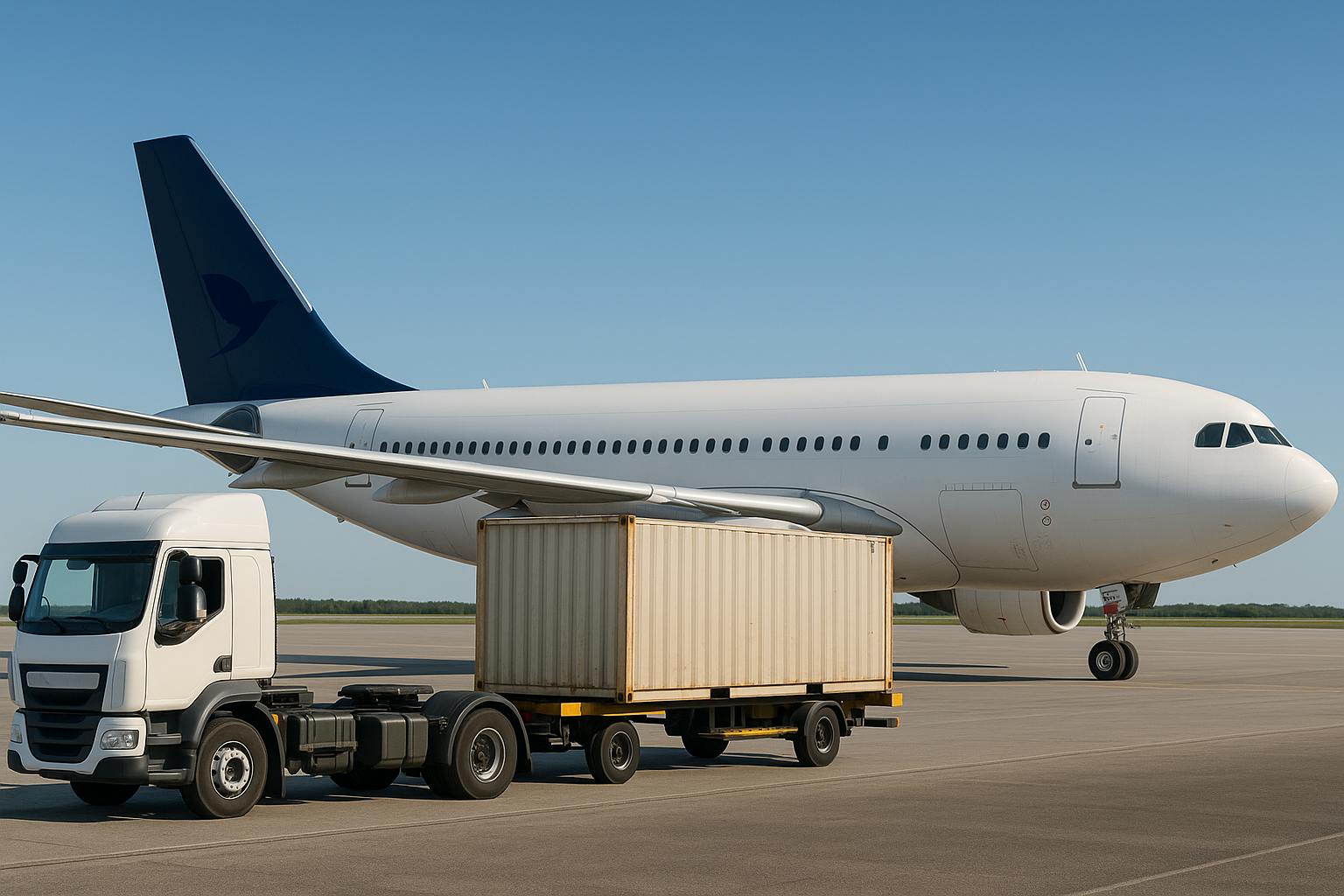
Cross-Border Commerce
Sep 19, 2025 - 6min read
ARTICLE
Why Multi-Carrier Strategies Matter More in Cross-Border Deliveries
A customer in Paris orders their favorite skincare products from a New York brand, while another customer in Tokyo purchases luxury fashion from Milan. Both expect fast, transparent delivery with real-time tracking and seamless customer service. Behind the scenes, however, no single carrier can make that promise globally. The complexity of cross-border commerce requires a fundamentally different approach than domestic shipping—one that demands flexibility, redundancy, and strategic carrier partnerships.
The Explosive Growth of Cross-Border E-commerce
The numbers tell a compelling story. The global cross-border e-commerce market size is estimated to reach USD 2,006.98 billion by 2034, rising from USD 477.51 billion in 2024, at a CAGR of 15.44%. This explosive growth isn't just about volume—it's about rising customer expectations that transcend borders.
Mobile is a big driver. Smartphones already account for ~55–60% of all e-commerce purchases globally (and 54.5% of U.S. holiday 2024 transactions), with forecasts pointing even higher through 2027. These mobile-first consumers expect the same seamless experience whether they're shopping domestically or internationally, creating unprecedented pressure on retailers to deliver consistent, reliable cross-border fulfillment.
The Complexity of Cross-Border Deliveries
Cross-border shipping introduces layers of complexity that domestic deliveries simply don't face. Unlike a package traveling from Chicago to Dallas through a single carrier's network, international shipments often involve multiple handoffs:
Multiple Carrier Handoffs: A typical cross-border shipment might start with a domestic carrier for first-mile pickup, transfer to an international freight forwarder for ocean or air transport, pass through customs clearance, and finally reach a local last-mile carrier for final delivery.
Varying SLA Standards: What constitutes "next-day delivery" in Manhattan differs drastically from expectations in rural Mexico or suburban Australia. Service reliability varies by lane and season, and no single carrier performs best everywhere.
Dynamic Cost Structures: International shipping costs fluctuate based on fuel prices, currency exchange rates, seasonal demand, and geopolitical factors. Tariffs and duties vary widely by product category and country, often creating significant impacts on shipping costs and planning.
Fragmented Tracking: When multiple carriers handle different legs of the journey, customers often lose visibility mid-transit. This leads to what industry experts call "black holes" in the shipping experience, where packages seem to disappear for days or weeks.
The Pitfalls of Single-Carrier Dependence
Many retailers start their international expansion with a single-carrier approach, often extending their successful domestic partnership globally. This strategy, while simple, creates significant vulnerabilities:
Limited Global Reach: No single carrier excels in every market. FedEx might dominate in North America, but a regional carrier could offer better service and pricing in Southeast Asia.
Bottleneck Vulnerability: Shippers often have to work with multiple carriers for a single shipment, each with its own systems and schedules. When your primary carrier faces strikes, weather disruptions, or capacity constraints, your entire operation grinds to a halt.
Pricing Power: Without alternatives, retailers have limited negotiating power. Single-carrier relationships often start with attractive rates but become expensive as volume grows and competition disappears.
Customer Satisfaction Risks: “Where is my order?” (WISMO) inquiries drive a huge share of support volume. They typically account for 25–35% of customer service contacts and can spike to ~50% during peak seasons. With each call costing about $5+ to resolve, a single carrier underperforming can quickly overwhelm customer service teams.
Why Multi-Carrier Strategies Matter More in Cross-Border
The complexity of international logistics makes multi-carrier strategies not just beneficial, but essential for sustainable growth:
Flexibility by Geography and Product
Smart retailers use different carriers for different lanes. A fashion retailer might use DHL Express for time-sensitive shipments to Europe, a regional carrier for cost-effective delivery to Latin America, and a specialist logistics provider for heavy items to Australia. This geographic optimization ensures customers receive the best possible service regardless of location.
Cost Optimization at Scale
An e-commerce retailer specializing in electronics used an automated carrier rate shopping platform to cut costs. By routing orders dynamically, they achieved up to 20% savings while maintaining fast delivery times. When multiplied across thousands of international shipments, these savings directly impact profitability and competitive positioning.
Risk Management and Business Continuity
Diversification protects against disruption. When COVID-19 grounded flights and disrupted global supply chains, retailers with multi-carrier strategies could quickly pivot to alternative routing options, while single-carrier dependent businesses faced weeks of delays.
Enhanced Customer Experience
Different customer segments have different priorities. Business customers might prioritize reliability and detailed tracking, while consumers focus on speed and cost. Multi-carrier strategies enable retailers to offer tailored shipping options that match customer preferences and willingness to pay.
Carriyo's Multi-Carrier Advantage
Carriyo has built its platform specifically to address cross-border multi-carrier complexity, offering several key capabilities that transform logistics challenges into competitive advantages:
Automated Carrier Assignment
Rather than manually selecting carriers for each shipment, Carriyo's intelligent routing engine automatically assigns orders to the optimal carrier based on factors like destination, product type, delivery speed requirements, and cost thresholds. This automation reduces errors while ensuring consistent optimization across all shipments.
Real-Time Rate Shopping
The platform continuously compares rates across all connected carriers, ensuring every shipment uses the most cost-effective option available. This real-time optimization can yield significant savings—particularly important for cross-border shipments where rate differences can be substantial.
Centralized Tracking and Visibility
Even when multiple carriers handle different legs of a journey, customers see a unified, branded tracking experience. Carriyo aggregates tracking data from all carriers and presents it through consistent, professional tracking pages that maintain brand continuity throughout the delivery process.
Intelligent Returns Management
International returns are notoriously complex, often involving different carriers, customs procedures, and cost structures than the original shipment. Carriyo's returns portal automates much of this complexity, providing customers with clear return options while optimizing reverse logistics costs for retailers.
Performance Monitoring and Analytics
The platform provides real-time SLA monitoring across all carriers, enabling quick identification of underperforming providers. This data-driven approach allows retailers to make informed decisions about carrier relationships and quickly reroute volume when performance issues arise.
Case Study: Transforming Cross-Border Operations
Consider the transformation documented in Carriyo's customer case studies. Sephora, operating across multiple markets with varying delivery expectations, implemented Carriyo's multi-carrier platform and achieved remarkable results: a 30% reduction of customer service calls within the first month of deploying triggered communications and a unified tracking experience across all customers.
Level Shoes achieved similar success with their cross-border expansion, reaching high service levels across all delivery types and eliminating manual effort to manage and print shipping documents. Most importantly, they achieved real-time visibility of shipment status, eliminating the tracking black holes that plague many cross-border operations.
Preparing for Cross-Border Growth in 2025
As we move into 2025, successful cross-border retailers should focus on several key areas:
Audit Your Carrier Dependencies: Map your current shipping volumes by destination and identify single points of failure. Are you overly dependent on one carrier for critical markets?
Build Backup Capacity: Establish relationships with alternative carriers before you need them. Carrier onboarding can take weeks or months, so prepare contingency options during slower periods.
Prioritize Customer Communication: WISMO can account for up to 40–50% of support inquiries during peak, so invest in proactive communication systems that keep customers informed throughout the international delivery process.
Leverage Data for Optimization: Use shipping analytics to identify optimization opportunities. Which carriers consistently outperform in specific regions? Where are your highest customer service costs? Data-driven insights enable smarter carrier selection and routing decisions.
The Competitive Imperative
The mathematics of cross-border commerce are unforgiving. Multi-carrier shipping now offers businesses strategic advantages, including cost savings, increased flexibility, and the ability to negotiate better rates. In domestic markets, a strong single-carrier relationship might suffice, but cross-border complexity demands a more sophisticated approach.
Retailers who embrace multi-carrier strategies position themselves for sustainable international growth. They can adapt quickly to changing market conditions, optimize costs across diverse shipping lanes, and most importantly, deliver consistent customer experiences regardless of destination.
The future belongs to retailers who view shipping not as a necessary cost, but as a strategic capability. In fact, the B2C segment accounts for ~69.8% of the cross-border e-commerce market, underscoring the importance of meeting end-consumer delivery expectations.
Conclusion
Cross-border e-commerce represents one of the greatest growth opportunities of our time, but success requires rethinking traditional shipping strategies. While domestic deliveries might work well with single-carrier approaches, international commerce demands the flexibility, cost optimization, and risk management that only multi-carrier strategies can provide.
The complexity is real—multiple handoffs, varying regulations, dynamic costs, and heightened customer expectations. But with platforms like Carriyo, retailers can transform this complexity into competitive advantage. Through intelligent automation, real-time optimization, and unified customer experiences, multi-carrier strategies become not just manageable, but profitable.
The question isn't whether your business will expand internationally, but whether you'll be ready with the infrastructure to succeed when you do. In 2025 and beyond, multi-carrier shipping isn't just a nice-to-have capability—it's the foundation for sustainable cross-border growth.
Ready to transform your cross-border shipping strategy? Contact Carriyo's sales team or book a demo today to discover how multi-carrier automation can turn your international logistics challenges into competitive advantages.
01

Joao Vieira
CRO at CARRIYO
Inside the City: How Urban Freight and Micro-Distribution Are Redefining the Last Mile
Oct 7, 2025 - 4min read
02

Faisel Azeez
Co-Founder & CTO
Connected Fleets: How Telematics and Data Are Powering the Next Generation of Logistics
Oct 6, 2025 - 5min read
03

Joao Vieira
CRO at CARRIYO
Last Mile, First Priority: Why Experience Matters More Than Speed
Oct 2, 2025 - 5min read
Automate shipping operations and elevate post-purchase customer experience
We're trusted by

